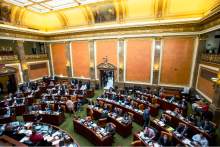This is an archived article that was published on sltrib.com in 2017, and information in the article may be outdated. It is provided only for personal research purposes and may not be reprinted.
Utah is one of the most conservative states in the country, and Republicans have long controlled the state Legislature. But an Associated Press analysis shows the state's legislative districts were drawn in a way that may have given the GOP extra help.
The Associated Press reviewed about 4,700 state House and Assembly seats up for election in 2016 using a new statistical method of calculating partisan advantage.
The analysis is based on the "efficiency gap" formula developed by University of Chicago law professor Nick Stephanopoulos and Eric McGhee, a researcher at the nonpartisan Public Policy Institute of California. Their model was cited recently by a federal appeals court that found Wisconsin's Assembly districts were intentionally gerrymandered in favor of Republicans.
The formula compares the statewide average share of the vote that a party receives with the statewide percentage of seats the party won, taking into account that in politics, each percentage point share of statewide votes generally accounts for a 2 percentage point increase in seat share.
The AP reviewed efficiency gaps for all states that had partisan state House or Assembly elections last year and found that most state chambers skewed Republican, including Utah.
Republicans on average won 64 percent of the votes in each district, but they won 83 percent of all state House seats.
The AP's analysis found that Republicans in Utah gained about three legislative seats last year in excess of what's expected in a typical ratio of votes to seats.
The data doesn't identify any particular districts where the legislative map, redrawn by state lawmakers after every 10-year census, might give Republicans a leg up.
Even if that advantage was neutralized and Democrats were given three more seats, Republicans would still control the state House by a supermajority well above a key two-thirds threshold required for matters like passing legislation that amends Utah's Constitution, impeaching officials or expelling a member of the Legislature.
The AP also analyzed congressional districts, but political scientists warn those measurements are less statistically significant in states with fewer than six or seven U.S. House seats like Utah.
Republicans won an average of 67 percent of the vote in of Utah's district last year but won all four of Utah's U.S. House seats, giving the GOP nearly one seat beyond what would be projected in a votes-to-seats ratio.
If Democrats had won Utah's 4th Congressional District, the most competitive, than GOP control of the seats would be closer to what would be expected based on the party's average vote share.
Incumbent Republican Rep. Mia Love won that district in November with 54 percent of the vote, defeating Democrat Doug Owens.



